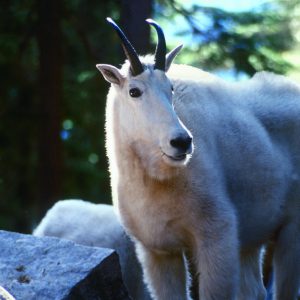Editor’s Note: This post was co-authored by Andrew Miller and Stevie Gawryluk, written from the perspective of Andrew Miller. Gawryluk served as ICL’s Community Engagement Assistant. Miller was born and raised in Idaho, where his affinity for fishing began.
From its headwaters in eastern Idaho and Wyoming, the upper tributaries of the Snake River boast some of the best fishing on the planet. The situation is much different downriver and across the state to the Oregon border. The once-mighty river dwindles to a trickle in places. Hot and full of pollution from agriculture and other industries, the river is plagued by algae outbreaks, killing fish and prompting warnings for humans and their pets to stay out of the water. The Snake River has defined much of the history in the region, and through “Stories of the Snake,” we bring to light the adventures and economic, historical, and cultural values this mighty river has provided for generations, and why stronger protections are needed to keep it this way.
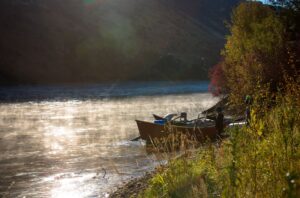
Generations of Tales
Fishing grounds a person. It forces them to be in the moment, awaiting the adrenaline-inducing moment of a fish hitting your line. Since the beginning of time, fishing has fed and entertained humanity. It is a skill passed from generation to generation. Wisdom, finesse, skill, tactics – all are passed down from an experienced fisherman to an up-and-coming one.
In east Idaho, this is no different. Generations of Native Peoples fished the waters of the region, feeding their Tribes and sharing their skills and knowledge. When pioneers arrived, the fruitful abundance of the waters provided and supported life, and they too, learned the ways and passed their knowledge down.
To this day, fishing comprises much of east Idaho’s identity. No matter who you are in east Idaho, fishing is a part of life. Those who don’t fish usually have family members that do. Those who fish may find themselves out there once in a while, or every day. My family is no different – generations have embraced the Snake, and at a young age, the art and skill of fishing was shared with me. It still remains a significant part of my life.
Starting Young
I was a handful as a child, with more energy than I knew what to do with. Raised by a single mother in Pocatello, we would head to Idaho Falls to spend time with our grandma whenever she needed a break from my brother and me. Grandma was a patient, kind, soft-spoken Idaho woman, who loved to fish. I’m not sure how this small, five-foot-something woman got into fishing, but I imagine it was because she was a depression-era child and had to learn out of necessity. And, like so many in east Idaho, she passed her knowledge and passion for fishing to the next generation.
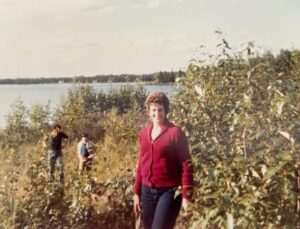
Fishing gave grandma reasons to go outside. It was an affordable way to feed her family, and gave me, her active grandson, something to do. We would head out to the Snake River and the small ponds around the watershed, spending countless hours on the water’s edge. My brother would often bury his nose in books while I sat with a rod in my hands, learning difficult lessons about the concept of “patience.” I constantly fidgeted with my rod and bait, and struggled to wait. Grandma would tell me to wait and leave the bait, but over and over I would throw my line in, wait a short period, then convince myself that because I had not caught a fish in a few short minutes, I needed to change the bait and cast again. As I did this, I’d watch grandma patiently wait with her line in the water and catch fish. It was not until later in life that I realized my grandma’s patience was incomparable to many, and was an attribute that made her a better angler. As I grew as an angler, I learned the value of patience, which allowed me to land more fish.
I don’t remember the first time I caught a fish, but I remember the first time I held a fly rod. One summer, grandma signed me up for an Idaho Department of Fish and Game class similar to their program, ‘Take me Fishing.’ We drove to a small stocked pond near Idaho Falls and met with Fish and Game officers, where they had push button rods that most kids use at some point when they are learning to fish. As a five-year-old that had already been using a spinning rod, I wasn’t interested in the push-button rods they had for us – but a fly rod that one of the dads brought quickly caught my eye.
I looked at this mysterious rod, wide-eyed and intrigued. The man saw how enamored I was by the rod and asked if I wanted to try it. I didn’t hesitate – I took the big rod in my small hands, and found myself awestruck by this familiar but foreign object. He showed me how to cast with ease and grace. I followed his lead, expecting to cast like him; but instead, found myself with tangled line. At that moment, I was hooked – and knew I wanted to become a fly fisherman.
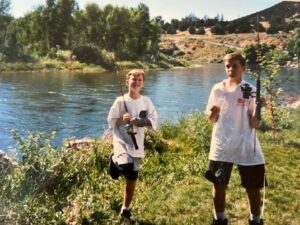
Leaving its Mark
The years have passed since I was a boy on the water’s edge with grandma. I have evolved as an angler. I have caught monster-sized rainbow in the Snake, accidentally hooked into a sturgeon that scared me in ways I would hate to admit, and embraced the importance of patience. In college, I saved money for hunting ammunition by eating the fish I caught – fishing out of necessity, like I imagine it had been for grandma.
The Snake developed me as a person and defines so much of who I am today. It taught me to fish, hunt, and experience nature on a deeper level than most have the opportunity to experience. One of my fondest and most cherished memories on the Snake happened when I was a teen, and watched the mating ritual of bald eagles for the first time. I was silently sitting in a duck blind near American Falls dam, covered by the stillness of the evening sky when all of a sudden above me, I saw something I had never seen before. Two bald eagles had their talons interlocked, and they were pummeling toward the earth in a terrifyingly spectacular freefall. I sat mesmerized. This is just one of many special moments I’ve had in the region, and I owe them all to the Snake.
Changes Over Time
From irrigation to recreation, this river provides life and opportunity for so many, but there are negative changes that have been noticeable, and it worries me. As a regular angler and hunter, I have seen changes over time. I have witnessed an increase in algae blooms and non-native species like carp, dangerous increases in water temperature, and a decrease in water quantity.
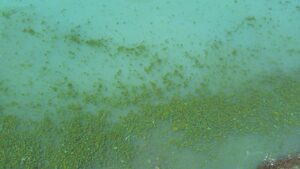
As a kid, I don’t recall algae advisories. Maybe I ignored them, but now it feels like we see more and more algal bloom outbreaks and health advisories. There are parts of the river I could never access when I was younger because there was too much water, but now I can access them more than I’d like to think about. How do these changes impact the fish that have fed generations of my family? What happens if these changes continue to worsen? Will the Snake be able to support the life it has for ages?
Saving the Snake

Not all boys learn to fish from their grandmas, but I am happy I did. Her determination and patience to teach her rambunctious grandson developed me in more ways than she could have imagined. I have become an avid fisherman and conservationist determined to care for the natural wonders that formed me. As I watch the decline in water quality and quantity along the Snake, I see a need for more people to speak up for the lifeline of eastern and southern Idaho.
One of the most significant ways we can save the Snake is by getting more people out on the water. Grandmas, grandpas, aunts, uncles, moms, and dads need to get their children out on the water. A cheap rod can catch big fish. Fish and Game has ADA-compliant fishing areas, allowing people with physical limitations to participate. Fishing is an activity for everyone, and it is an activity that can build a powerful voice for this precious resource.
The Snake River is the lifeline of eastern and southern Idaho, and it cannot continue down the path it is on. Overallocation must be minimized, polluters have to be held accountable, and community members must do their part. The Snake has supported generations of my family, and I know it has provided the same for so many other families across eastern and southern Idaho. It is up to all of us to uphold the value of the river to ensure future generations have the same opportunities we have had.
ICL is working to restore the Snake River to a safe, swimmable, fishable condition. So many rely on the Snake River watershed’s water quality, and we must unite and work together to safeguard the river, hold polluters accountable, and promote efficient water use practices. Take action for the Snake River below by contacting Idaho’s elected officials, urging them to clean up the Mid-Snake. Sign up here to learn more about the Snake River and how you can help restore it, and remember to take action below!

